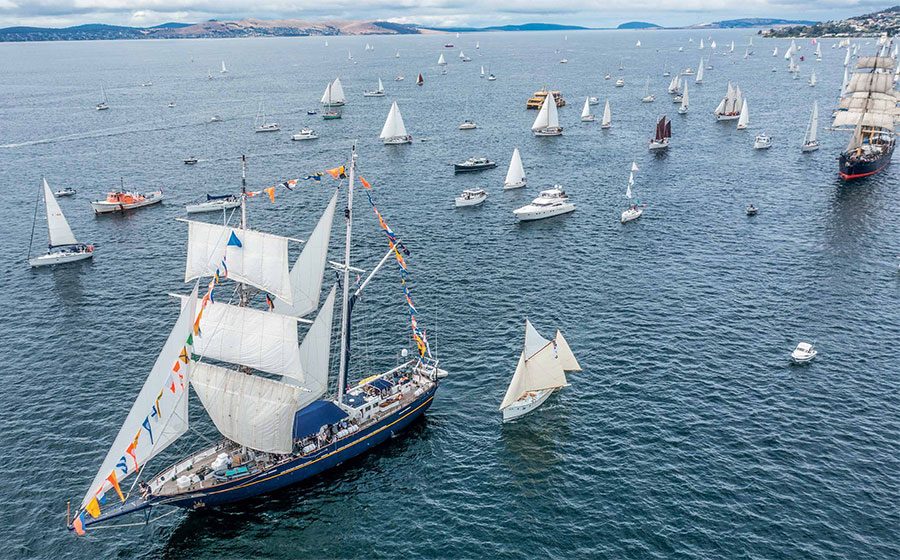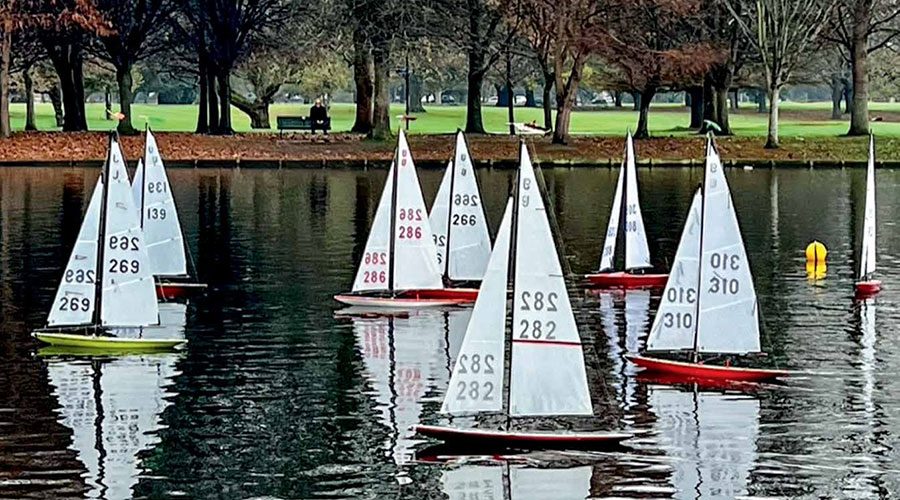

The seagulls in Hobart are more raucous and the air looks much clearer, concluded Boating NZ’s Australian correspondent Kevin Green, on deck amongst the Parade of Sail on Tasmania’s River Derwent.
Day one of the Australian Wooden Boat Festival was getting off to a grand start as 200 vessels of every size paraded in their finery, some fully dressed, and most with flags flying in the light breeze.
Leading the charge were the 10 tall ships that showed the colonial maritime history, including the giant James Craig, right down to the tiny Duyfken, one of the earliest colonial visitors from Holland, which first charted Western Australia in 1606.
The Parade of Sail showcased a variety of recreational and commercial vessels that sailed across the River Derwent to enter the festival site at Constitution Dock. It was led by the Governor, Her Excellency Honourable Barbara Baker AC, on the motoryacht Egeria, a 1941 huon pine cruiser. She told me, “As a proud Tasmanian, the festival is not just a celebration of our heritage, but also a vital part of our economy,” she said.

Offshore a day later, the Derwent World Championships saw the river dotted with racing sails and towards the festival end, a special Ketch Review. Each day the air was filled with sound of jet engines as the Roulettes Aerobatic Team buzzed the Tasmanian capital and crowds jostled on the pontoons below.
Later, at the symposium theatre, Duyfken crew member Mirjam Hilgeman explained to a captivated audience how the 20m replica, launched in 2009, is sailed. Distinguished audience members included Australian America’s Cup winning skipper John Bertrand, who asked how such a vessel could sail around the world, given it could hardly go to windward. Other audience members questioned the stability of the little cog-like ship – typical of the interesting conversations at this symposium and several others during the four-day festival.
Hobart is Australia’s most glorious maritime city. Nestled at the top of infamous Storm Bay, midway down the island’s east coast, it is surrounded by sheltered cruising grounds I’ve enjoyed many times over the decades. It is so worth making the challenging voyage over the Tasman Sea for a visit. The surrounding areas especially worth visiting include Mount Wellington, overlooking the city, and the most famous of all its attractions, the internationally renowned avant garde Mona Gallery.

KIWI YACHTS
On the quays amid the many gleaming historical vessels were newer ones, to remind the thousands of visitors that a vibrant wooden boat building industry exists in Tasmania. Among the internationals was a former New Zealand-based yacht that was originally built in England, Te Rapunga. Aboard the Te Rapunga boatbuilder Ken Studley told me how she was rebuilt by Denman Marine, after finding remains of the original hull rotting in New Zealand. With only the ballast and some bronze fixtures remaining, she was restored over three years and launched in 2020. Some of Denman’s staff did most of their apprenticeship on this boat. Their order books are fairly full, young apprentice Lockey told me.
With the name Tui of Opua, the immaculate Vertue 26 owned and built in 1994 by Bruce and Thelma Morely, belies the couple’s Kiwi connections. They built it on the east coast of Australia in 1994 out of Honduras mahogany and use a spruce mast. These hardy liveaboards have been cruising the Australian east coast for the last 25 years and are regular attendees at the Hobart Festival. They are friends of mine, so it was good to escape the hot sun and go below for a cuppa and yarn. “It took us about a month of sailing to get here, after we left Newcastle,” said Bruce. Thelma goes ashore at the festival to demonstrate her articulate rope work and the couple plan to overwinter in Tasmania before sailing back across Bass Strait next summer.
America’s Cup history was also on display in the form of the elegant Gretel II, Australia’s 1970 challenger for the auld mug. The 12m class was designed by one the country’s leading architects, Alan Payne, and built by William Barnett in Tasmania. Gretel II also challenged in the 1977 Cup. Made of Oregon pine, the carvel-laid sloop shone immaculately in the Tassie sun as a new generation of sailors viewed her sleek topsides and vast Lewmar coffee grinders.

TAWE NUNNUGAH
A harsh colonial invasion ensured few relics survive from Tasmania’s indigenous population, apart from middens that are seen in some of the remoter places I’ve come ashore, such as Port Davey and Bathurst Harbour in the unpopulated southwest. However, their words – Tawe Nunnugah – have been remembered in the naming of the small-boat Raid cruise that meets at Recherche Bay biennially.
It’s a Palawa tribe phrase for ‘voyaging by canoe’, which is similar to the European word ‘raid’, as in ‘inspired by raiding parties’. Glamorised by the Vikings, who were skilled at sail and oar; using shallow-draft vessels to explore far inland. Similarly, the Tasmania Raid invites small boat sailors to coastal hop north for 10 days. This is done within sheltered waters inside Bruny Island before the more open-water grand finale of Storm Bay, the Derwent River and Hobart, where raiders are advised to behave better than the Vikings on their arrival at Constitution Dock.
Some will have rowed and raced hard in traditional boats known as St Ayles skiffs. Double-ended dories, built for sail and oar originally used in the far north of Scotland on Fair Isle, these were replicated by Australian designer Iain Oughtred to become the popular St Ayles skiffs. The simple design caught the imagination of many groups worldwide, who often gather to build one from a kit before participating in rowing events. This year’s RAID had more than 30 boats in total.


TIMBER TALK
The festival is an important forum for the wooden boat building industry, and this was reflected across the symposiums held in the theatre on the quay. ‘The Future of Boatbuilding Wood’ symposium was a particular highlight, which discussed the plight of the industry in sourcing timber for new builds. Sourcing the specialist woods on the island has been increasingly more difficult as environmental concerns limit supply.
Huon pine is unique to Tasmania and is slow growing, with some specimens thousands of years old. Huon pines are some of the oldest living organisms on Earth, with one stand of them found in 1955 to be in excess of 10,500 years old! This slow growth creates a dense yet light, resinated timber that has been ideal for boatbuilding throughout the last century. Other speciality timbers used in boatbuilding include King Billy, celery top and swamp gum. Apart from the maritime use, other timbers found here such as black heart sassafras, myrtle and blackwood are used by instrument makers and the furniture industry. As an example, a tabletop of one of these sold for A$6,000 at the festival this year.
Tasmania pioneered Australia’s fledgling environmental movement and continues on this path, but clearly there are challenges, including sustainable fish farming and the timber industry. Yet boatbuilding requires about only one percent of the timber resource and is a vital part of the economy and culture in this most beautiful isle. However, Denman company boss and president of the Tasmanian Speciality Timber Alliance (TSTA), Andrew Denman, argues that the state’s boat building industry is under threat: “It is a combination of deliberate market distortion and resource mismanagement by Sustainable Timber Tasmania, and a failure of Government policy implementation,” he told the Hobart Mercury newspaper.
TSTA figures estimate that speciality timber log volumes have decreased by 89% since 2011. Given that the industry contributes roughly A$20-30 million to the local economy and employs 200 people directly, there is a clear need for sustainable resources to facilitate it. This was a fact Tasmanian Minister for Resources, Felix Ellis, acknowledged during a video address to the audience at the Future of Boatbuilding Wood symposium I attended.
Another senior mainland boatbuilder, Tim Philips from Sorrento Wooden Boats, told us he’d been unable to source Tasmanian timber, such as huon pine, for about 20 years; using mostly African timber instead. Co-festival founder, author and sailor Ian Johnston spoke passionately about the future for the local industry, while tall ship captain Sarah Parry explained how her vessel Windward Bound was built using wood in a more economical fashion, employing the strip plank/epoxy method in swamp gum.

WOODEN BOAT SCHOOL GRADUATES
A former surgeon and a Boeing 747 airline pilot are two of the eight students graduating from the Wooden Boat School at Franklin in the Huon Valley, Tasmania. The students come from all parts of Australia and have completed a one-year, hands-on course in boat building. They have built six new vessels and restored two. “The Wooden Boat School is one of Tasmania’s best-kept secrets,” said Peter Schulz, a former airline pilot who sailed his own yacht from Sydney to join the course. “I know of nothing like it elsewhere in Australia.”
Dr Michael Vaughan gave up his practice as a surgeon to pursue his love of wooden boats. “It is such a privilege to be able to build boats using the best boat-building timbers in the world, such as huon pine, which are only available here in Tasmania,” he said.
“It has been great to get back to normal after Covid disrupted student arrivals from interstate in the previous two years,” said Cody Horgan, chief instructor at the school. “This year’s cohort has been an extraordinary mix of ages and backgrounds and shows the enthusiasm out there for keeping alive boat-building skills.”
Mr Horgan is a former student at the Wooden Boat School who went on to work interstate, including being responsible for maintenance of the vessels at the National Maritime Museum, Sydney.
“The school is keeping alive, and building on, Tasmania’s wooden-boat-building heritage,” said Mr Horgan.
There have been surprises for some of the students during the year. Sarah Hodgman gave up nursing at a Canberra hospital to try her hand at boat building. Much to her surprise, she discovered her skills in fine woodwork by turning out exquisite pieces, including an ornate sea chest with wooden hinges. Jack Witte, a master craftsman and restorer of heritage buildings, faced challenges: “I have been working with wood since I was 14 years old, but the lack of straight lines in boats has challenged me,” he said.
The final new-build out of the school for the year belongs to Keith Gimbert from northern Queensland. He and his wife Sharon moved to Franklin, Tasmania for three months so Keith could work on the build of his huon pine Whitehall dinghy alongside students. “There is nowhere quite like here,” he said. “The access to the woods like huon pine, and the people with skills is unparalleled.”


LOOKING FORWARD TO 2025
The February 2023 event in Hobart welcomed a recordbreaking number of interstate boats and throngs of crowds, estimated to be 90,000, during four sunshine-filled days. In total 354 vessels registered, with 38% from interstate. “It has been a fantastic weekend of celebrations, with our boating community from near and far,” said AWBF General Manager Paul Stephanus.
The festival hosted a huge variety of floating vessels, static displays of smaller ones, shipwright demonstrations and stalls of various marine goods, as well as food. Entertainment offered included sea shanty singing and various theatricals. Other Festival highlights included 10 local and interstate Tall Ships which departed Sullivan’s Cove daily with joyriders who experienced the vitality of the past age of working sail. And it will all happen again in 2025 (7–10 February). www.awbf.org.au BNZ



